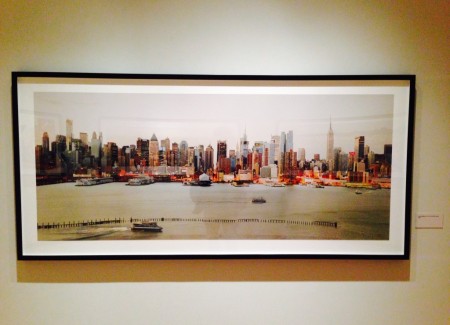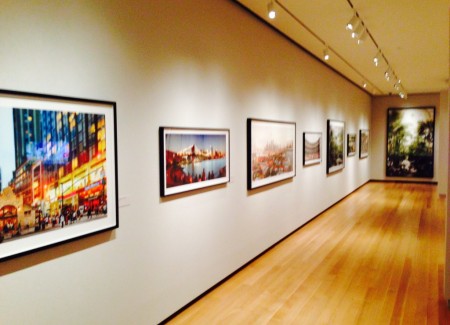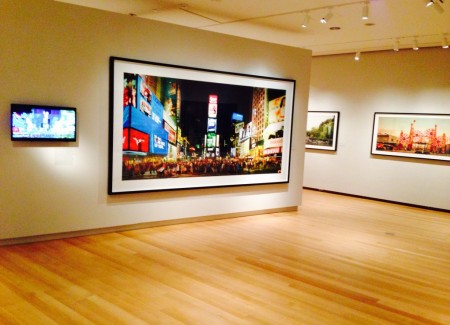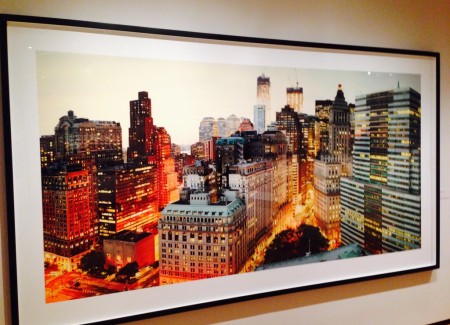JTF (just the facts): A total of 57 large scale color photographs, framed in black wood and matted, and hung against cream colored walls in the hallway and a partitioned gallery space on the museum’s third floor. All of the works are archival pigment prints. Physical sizes range from 20×48 to 60×100, with the majority being 30×72. A companion volume to the exhibit, entitled New York, was recently published by Aperture (here, hardcover, 13 3/8 x 16 ½ inches, 100 color photographs, with a foreword by Justin Davidson and an afterword by Sean Corcoran, $95). (Installation shots below.)
Comments/Context: Jeff Chien-Hsing Liao’s giant prints of (mostly) famous places around the five boroughs of New York City—from the Bronx Zoo to Coney Island—are crowd-pleasers. Broad and clear enough in their descriptive sweep for these sites to be identifiable without a caption, his panoramas deliver a punch right between the eyes. At the same time, they are veined with busy detail that New York high school teachers will appreciate. Students will often stop fidgeting if they are asked to decipher photographs that have a lot going on. Liao’s do.
Each of his images is made up of smaller ones (from 20 to 400) taken over the course of a single day and sewn together into a believable whole with digital editing programs. Everything here dates from the last 10 years when he began using an 8×10 camera; since 2010 he has been shooting digitally, too.
In his early work, Liao photographed near his home in Queens, scenes such as the immigrant food stores beneath the elevated subway tracks at Woodside; commuters heading to the LIRR station at Hunter’s Point; a passing subway train at 5 Points in Long Island City; and the cluster of car repair garages (the so-called Iron Triangle) in Willets Point. Light on the worn brick, concrete, and metal surfaces of things in these 2004 images is either lush and romantic (the suffusing red of early morning/late afternoon sun) or gray and flat.
The color in his recent pictures is often more diaphanous and cheerful, as if to support the upbeat vision of a prosperous New York favored by the economic policies of the Bloomberg administration. Liao’s attitude toward these developments is hard to discern. He may simply be noting the fact that gentrification has arrived in neighborhoods that hadn’t seen much of it before, as in corners of downtown Brooklyn where a well-lighted Shake Shack now stands (2012) not all that far from the Barclays Center (2013).
Elsewhere, he may be questioning the wisdom of purging the city of its traditional vice and small businesses, as in the remodeling of Times Square into a family-friendly amusement park with an M&Ms store. His 2011 panorama of the block on 42nd Street between 7th and 8th Avenues has a satiric tinge. He portrays it as a frieze of buildings, as earlier black-and-white photographers have done. In Liao’s candy-colored version, however, the deuce is just another Vegas strip mall.
A more rigorous edit would have improved the show and the book. The bird’s eye views (from Tracey Towers in the Bronx, One57 West on Central Park West, and Castle Williams on Governors Island) don’t add much of anything to our engrained sense of these places. The same can be said for his portraits of Yankee and Shea stadiums, and of the George Washington Bridge, seen in a long exposure so the West Side Highway appears devoid of traffic. (Fat chance of that happening.)
Liao excels when he sets up his camera near ground-level and he and it become part of the crowd. Many surreal photographs have been made over the decades of the Macy’s Thanksgiving Day Parade. His 2012 long shot of Spiderman and Kermit floating past the Dakota apartment house is another one. (Since 9/11 it may be the one morning of the year when New Yorkers look up at large things in the sky without a reflex of fear.)
More marvelous is Liao’s photograph of the Apple store on Fifth Avenue at night. The young crowd of visitors mingling out front is sharply in focus while the glass cube and the surrounding architecture have dissolved in a blur. Only the corporate logo of the bitten fruit remains, glowing whitely in the dark like Steve Jobs’ smile.
Liao’s crepuscular view of the renovated subway station at W. 72nd Street (2012) is euqally impressive, and in its balance of mood and information, his finest work to date. His camera faces south toward the intersection where Broadway and Tenth Avenue meet and switch sides around the concrete island. The evening sky is a pale azure and complements the industrial light (pinks, yellows, blues, reds) spilling from the signage on the buildings.
Anchoring the picture—and this neighborhood on the Upper West Side—is the control house, one of the original stations of the 1904 subway. The building’s very modesty is welcoming, its warm beige brick in keeping with the mild temperature of the air on that day. Hordes of pedestrians (there must almost a hundred) are heading off in various directions, while in the center of 72nd Street a young man is crouched and taking a photograph.
Liao is documenting the city with the distancing eye of the German landscape photographers, Struth and Gursky and Esser. Only one image here is newsworthy or topical: a 2011 nighttime view of the Occupy Wall St. protesters at Zuccoti Park. Even though he may be doctoring his images in Photoshop, they are bound to be of historic interest. (Assistant curators may one day be assigned to count the number of photographers in his images, an unavoidable motif for anyone who records crowds in the post-iphone era.)
What is often missing from Liao’s work is a distinct sensibility. Too many pictures here seem directed by consulting a tourist map of sites rather than by personal obsession or curiosity. Being indifferent to disruptive changes in the world is not the same as feeling deeply ambivalent about them. Barry Frydlender’s digital composites of scenes in Israel reveal his unease with the many forces (nationalist, religious, economic) tearing apart his country. Liao’s photographs don’t need to be any more technically proficient. He’s got that licked. What they need is more of Liao.
Collector’s POV: Jeff Chien-Hsing Liao does not appear to have gallery representation in New York at the moment. While a few of Liao’s prints have come up for auction in recent years, there haven’t been enough outcomes to generate much of a pattern; as such, gallery retail/connecting with the artist directly likely remain the best options for those collectors interested in following up.


















“What is often missing from Liao’s work is a distinct sensibility. ”
While nobody likes to hear that said about their work it is a key consideration in evaluating art photography – unfortunately it’s a really hard thing to fix.
I hope my review wasn’t a total downer for Liao. I suggested that in at least two photographs–of the Apple store and of
the subway station at W. 72nd St.–he was on his way to fixing that problem. Both have a strange light and life, an unusual focus. They seem to be about a specific time of day and are quite unlike the examples where he seemed to photograph
places without a lot of thought. If allowed, I would have given the show one and a half stars.